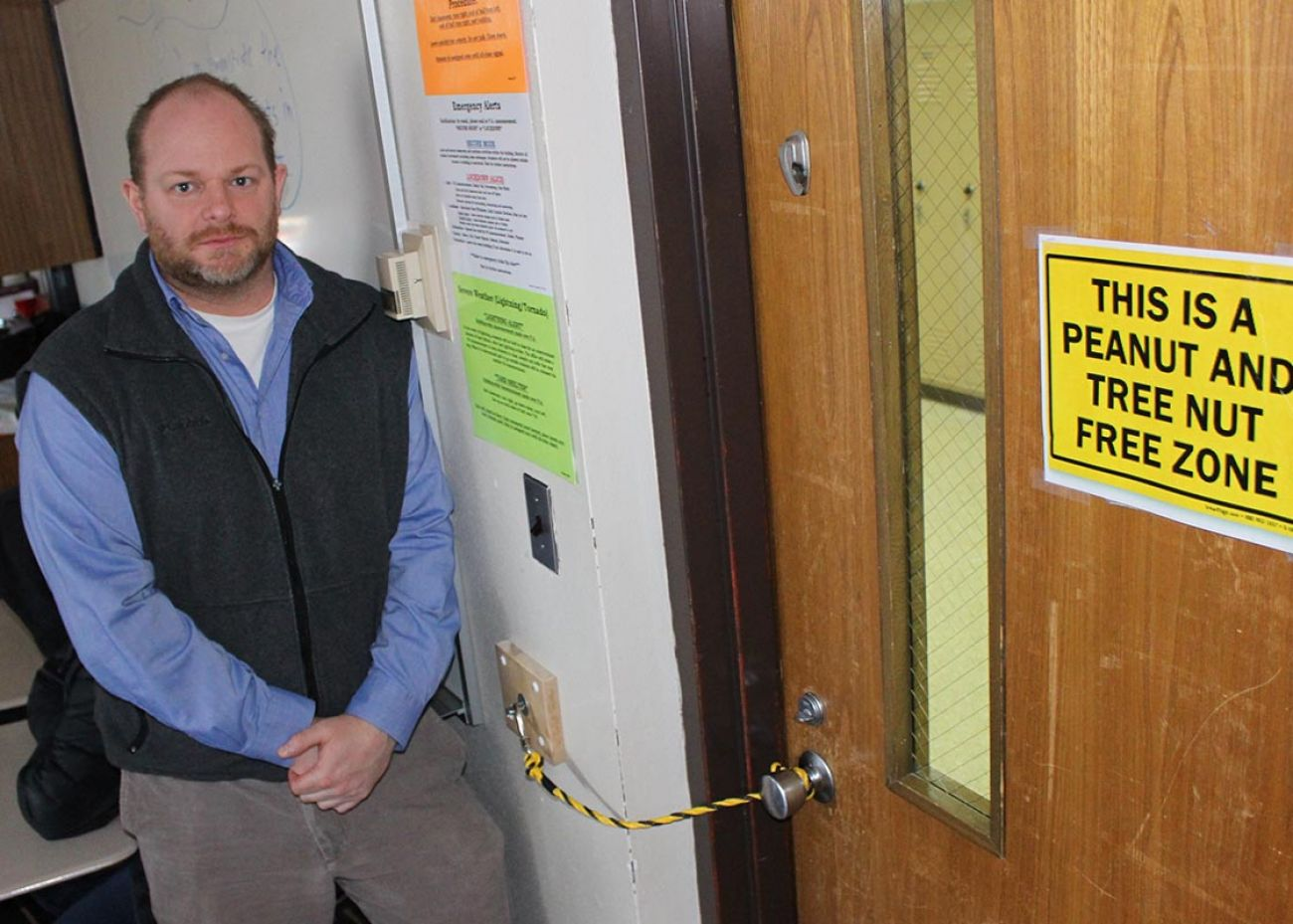Oxford Michigan school shooting shows limits of heightened security

Dec. 9: After Oxford shooting, Michigan Dems seek to bar high-capacity magazine sales
Dec. 3: The case against the parents of Oxford shooting suspect: Gun was Xmas present
Students and staff of Oxford High school acted quickly when shots were fired in their school Tuesday.
They locked and barricaded doors, as staff had learned in active-shooter training and students had practiced in drills. And, school leaders said, a police officer who worked at the school helped apprehend the suspected shooter minutes after the first shot was fired.
And still, three students died and eight others, including a teacher, were shot, authorities said.
Tuesday’s tragedy is the latest in an epidemic of school mass shootings in the United States in recent years. Since the Columbine high school massacre in 1999, schools across the U.S. have been hardened against attacks, with locked doors, metal detectors, on-campus police and video surveillance cameras. Most classrooms have devices that make it more difficult for a shooter to gain entry.
Related:
- Three students dead, eight injured at Oxford High School. Sophomore in custody
- In leggings, hoodies and sneakers, Oxford students mourn at church vigil
- Oxford High is seventh major school shooting in Michigan since 1978
- Michigan gridlock has blocked action on 50 gun reform bills this year
- 2019: Shooter drills. Anxious teachers. Flying staplers. Michigan schools prepare.
Yet there is a limit to what those security measures can do to protect students and staff, say Michigan school leaders.
“It sounds like Oxford did everything right,” said Jason Mellema, superintendent of Ingham Intermediate School District, who said he spoke to a school official who has a son who attends Oxford High School afternoon following the shooting.
“It’s a sober realization that the steps we take to mitigate damage don’t stop all the damage.”
According to the Oxford district website, the district contracted with the ALICE (Alert, Lockdown, Inform, Counter, Evacuate) Training Institute to provide active-shooter training for district employees. The district maintains a “safety committee” of school officials, local public officials, parents and community members. And it employs regular patrols on school grounds by Oakland County Sheriff deputies.
Oxford schools are equipped with video intercom systems. Visitors to school buildings during school hours must be “buzzed in,” according to the district’s website, and the high school has a full-time security officer.
Though the high school does not have metal detectors, school officials said Tuesday.
Rumors had apparently been spreading among students that something ominous could happen on Tuesday. One parent, Robin Redding, told the Associated Press on Tuesday that her son had stayed home from school, telling her he didn’t feel comfortable.
In the wake of the shooting, internet rumors were spreading that the shooter had initiated an online “countdown” to the shooting, prompting some students to fear for their safety.
Law enforcement officials acknowledged rumors circulating on social media but said nothing had yet been confirmed, AP reported.
Only last year did Michigan begin requiring every public school district in the state to develop emergency operations plans, though those plans do not have to be filed with the state, according to guidance posted on the Michigan State Police website.
Oxford’s district website indicates the district has a plan in place, with significant safety preparation apparently in place for years.
“We realize, no one is going to be able to prevent 100 percent instances like we’ve seen in the paper,” Oxford Assistant Superintendent of Business and Operations Sam Barna told a reporter for local news outlet The Citizen in 2015. “But that’s not an excuse to say we can’t do the very best we can do to try (to) avoid those types of situations, that’s our responsibility.”
Barna’s remarks six years ago proved eerily prophetic.
“They used the security measures there in the building with expert-level efficiency,” David Randels, director of government relations for Oakland Schools, the intermediate school district in the county that includes Oxford Community Schools, told Bridge MichiganTuesday.
“Everything worked. And it’s still a tragedy.”
It’s possible that the death toll could have been higher if the shooting occurred a decade ago, before Michigan school districts invested heavily in security, said several Michigan school leaders.
But those efforts vary widely, partly because schools typically pay for security measures out of the same budgets that pay teacher salaries and sports uniforms, and because the state doesn’t issue uniform guidance on school safety.
While the chances of a mass shooting at any individual school are astronomically low, active shooter preparation has become part of the fabric of school culture across the country. In Michigan, the steps taken to protect students from a shooter vary from teacher to teacher and school to school; from six-figure, high-tech gunshot sensors, to stacking desks in front of classroom doors, according to a 2019 Bridge Michigan report.
Protections sometimes included DIY innovations.
A teacher in Bronson, Michigan, kept hornet spray and a staple gun in his classroom to ward off an active shooter. In Grand Blanc, a high school teacher kept hockey pucks in a cupboard for students to hurl at an intruder.
From 2014 to 2019, the state handed out $56 million in school safety grants and in 2018 issued 32 pages of recommendations for active shooter plans.
But amid COVID-19 belt-tightening last year, lawmakers canceled plans to appropriate another $10 million-worth of school safety grants in fiscal year 2020.
Schools across Michigan are required to conduct at least three school safety and security drills yearly, and report certain crimes at schools to State Police within 24 hours. Districts also must discuss building safety plans with local law enforcement before building a new school or making a major renovation.
“We spend more time on active shooter drills than what we used to do on fire and tornado drills,” said Ingham ISD’s Mellema.
In 2018, the Legislature created a state Office of School Safety, which includes a manager, two analysts and two staff members devoted to the “OK2Say” violence prevention program, according to a Michigan State Police spokesperson.
But while a state task force in 2018 offered a host of recommendations to improve school safety, individual schools are largely left to their own devices to decide which, if any, recommendations they’ll follow.
As Tuesday’s shootings indicate, it’s not possible to entirely eliminate risk, such as when a shooter turns out to be a student with access to the building.
In the 2020-21 school year there were 49 student expulsions for possessing firearms in Michigan K-12 schools. There were far more — 110 — the year earlier, before the COVID pandemic, when students were in school the entire year, state school expulsion data shows.
Studies have pointed out the limitations of school security measures. Johns Hopkins University researchers, for example, found in 2015 “limited and conflicting evidence” of safety technology’s effectiveness.
Michigan generally bans people from bringing firearms onto K-12 school or onto a school bus, according to the Giffords Law Center to Prevent Gun Violence. Schools are required to expel students found with a firearm in a so-called “weapons free school zone.”
But there are many exceptions to the ban, including for residents who are at least 21 years old with a concealed carry license, guns provided by the school to instruct on how to use them, adults transporting a student to or from school in certain circumstances (such as on their way to go hunting), or anyone with permission from the principal or an authorized “agent of the school.”
School districts can and often do adopt stricter standards of their own.
In a statement Tuesday evening, former Arizona Congresswoman Gabrielle Giffords called for stricter gun laws in light of the Oxford shooting.
“Every day that our country does not pass lifesaving gun laws is another day that we fail our children, said Giffords, who became a vocal gun control advocate after being shot in the head during a 2011 assasination attempt in Arizona. “This tragedy didn’t have to happen. It’s long past time for our elected leaders to stand up to the gun lobby and pass common sense gun safety laws. Our children’s lives — all of our lives — depend on it.”
Before Tuesday’s shooting, Rep. Mike Mueller, R-Lindon, was expected to introduce an appropriations bill Wednesday that included $10 million for school resource officers — police officers stationed at schools whose salaries are paid for by school districts.
Mueller, who was a Livingston County sheriff’s deputy before resigning from the force to take office, told Bridge he used to spend his off-duty hours ready to respond in case something happened at Linden High School near his house.
To see Tuesday’s tragedy unfold just outside his district, he said, “is terrible.”
Given the large size of school buildings, he said, resource officers might not be able to stop a school shooter before they shed blood.
“But it's building relationships with the kids prior to that,” he said, “That can be a way of prevention.”
He said the appropriations bill could make its way to the House floor as early as this week.
In the wake of the shooting, Sen. Dayna Polehanki, D-Livonia, told Bridge she expected a push to increase that funding.
“We need to engage with our schools to come up with a number that would put school resource officers in every school district in Michigan,” Polehanki said. “In my view, there is no number that is too high when it comes to preventing our kids from being shot at school.”
But Ingham ISD’s Mellema suggested that more locked doors and bigger state grants will not necessarily eliminate the threat.
“Any time there’s a tragedy like this, we reflect on what schools can do better,” Mellema said. “I’d encourage parents and communities to do the same.”
“Schools cannot do this alone,” he said. “The best thing we can do to stop these things is to ask parents and communities to build strong relationships with their kids.”
Mike Wilkinson contributed to this report.
Michigan Education Watch
Michigan Education Watch is made possible by generous financial support from:
Subscribe to Michigan Education Watch
See what new members are saying about why they donated to Bridge Michigan:
- “In order for this information to be accurate and unbiased it must be underwritten by its readers, not by special interests.” - Larry S.
- “Not many other media sources report on the topics Bridge does.” - Susan B.
- “Your journalism is outstanding and rare these days.” - Mark S.
If you want to ensure the future of nonpartisan, nonprofit Michigan journalism, please become a member today. You, too, will be asked why you donated and maybe we'll feature your quote next time!






